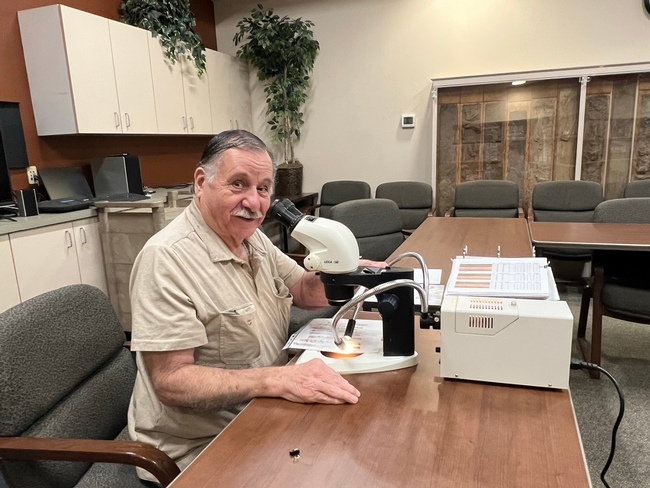Two UC ANR entomologists, Walter Bentley, IPM Advisor emeritus, and Richard Coviollo, Entomology Advisor retired, assisted with identifying male walnut scale insects while visiting with Elizabeth Fichtner, UCCE Tulare County Orchard Systems Advisor. Richard's work in the 1980s demonstrated that the winged male walnut scale individuals adhere to the double-sided sticky tape traps used to identify the timing of crawler emergence. In 1983, Richard observed that the male walnut scale emerged in late March, a key consideration with the recent advent of dormant and delayed dormant applications of insect growth regulators (IGRs) for management of the pest. Conversations between Walt Bentley, Steve Randall, crop consultant, and Fichtner led to the question of whether these early IGR applications may prevent the maturation of males, thus limiting sexual reproduction and subsequent crawler populations.
Coviollo stepped out of retirement yesterday to look at the archive of sticky tape traps collected throughout the 2023 season in an experiment conducted in collaboration with Bob Van Steenwyk, CE Specialist Emeritus, UC Berkeley. Van Stweenwyk and Fichtner established a trial to evaluate the efficacy of delayed dormant and crawler stage IGR applications with products such as Esteem® and Centaur®. Also included in the trial were crawler stage applications of Senstar® (a combination of an IGR and a lipid biosynthesis inhibitor) and Assail® (a neonicitinoid).
The male walnut scale insects were identified by Coviollo in the traps from late March 2023. Thanks to his expertise and experience, Fichtner can now determine whether the delayed dormant IGR treatments affected the emerged population of males, thus furthering our understanding of how this group of insecticides affects population dynamics of walnut scale.
From a research perspective, this experience emphasizes the value of publishing one's work, regardless of whether it is in peer-reviewed journals or searchable industry reports. One never knows when it may benefit a researcher 40 years later! Additionally, this experience emphasizes the value of the UC ANR system that fosters a sense of community, synergizing the efforts of UC researchers and industry professionals to solve problems affecting our agricultural systems.
Attached Images:
